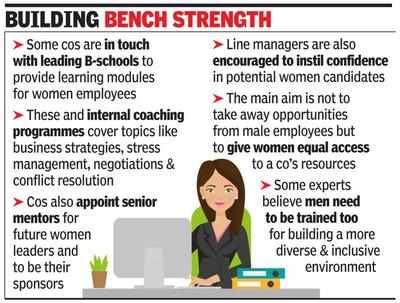
Cos look within for new woman leaders
by Namrata SinghNamrata.Singh@timesgroup.com
Mumbai: A firm recently decided to recruit a woman as the HR head. However, despite running the best possible search, it failed to find the right candidate. Organisations accept that there’s only a limited pool of women ready to take on leadership roles. And that the only way to get more women leaders is by developing talent internally. Long tenured learning and development interventions are being launched by organisations to help women break the glass ceiling.
One such programme called ‘Accel’ has been curated by Godrej Group for its 32 high-performing women managers. In this year-long programme, managers are mentored by key women leaders from the group, including Nisaba Godrej, and other internal leaders as well, with the focal areas being learning strategy, emotional, social awareness and, more importantly, influencing.
Godrej Industries Limited and Associate Companies (GILAC) group head (rewards, diversity & people productivity) Shefali Kohli said, “Given that there is an attrition of women at certain mid-levels, we said rather than reaching out and hiring women laterally, why don’t we develop them and build them from within our talent pool.” While at the manager cadre entry level, women representation stands at 30-35% for GILAC, at the leadership level it is around 17%. A leaky pipeline is a major reason why most organisations have fewer women leaders. “Research tells us that women are fairly sticky in their jobs. However, they prefer to work in immediate vicinities of their homes and it’s tough to retain them,” said Kohli.
Some women also struggle with networking and managing politics at work. “There’s a confidence versus competence issue. That’s why they say men take the plunge even if they’re 60% ready, while women do not even at 80% readiness,” said Kohli.
At the end of the tenure, when the group does an assessment of the shifts that were triggered by the development on the basis of inputs from managers and other key stakeholders, the women identified as ‘ready now’ would be considered for next level of roles as and when these emerge.
Pidilite Industries plans to create a programme to develop women leaders and is currently under discussion with the SP Jain Institute of Management & Research (SPJIMR). “We are committed to helping our women leaders at middle management grow to the next level of leadership roles and progress in their careers,” said Pidilite Industries CHRO Rahul Sinha.
Uber has rolled out a diversity and inclusion (D&I) sponsorship programme of six-12 months, targeting cohorts of 15-20 high-performing women who will be sponsored by director-plus level leaders at the firm. Uber India & South Asia HR business partner Neha Mathur said, “Having a sponsor, a career champion, and someone who advocates on their ‘sponsee’s’ behalf is a game-changing asset that is especially empowering for female professionals.”
“While men may inherently find it easier to form professional relationships and organically find sponsors for themselves, women can benefit from formal programmes to match them with sponsors. The rationale behind this programme is not depriving men from opportunities in the workplace but to create a level playing field and cultivate an environment that enables women to tap into company resources that can help develop and advance their careers equally,” said Mathur.
A few years ago, the Mahindra Group had started on a journey to mentor and coach 300 women in five years through its first Women Leaders Programme. A classroom learning in collaboration between Mahindra Leadership University and SPJIMR, the programme is said to have helped some women managers move up the career trajectory.
SPJIMR professor of marketing and chairperson (postgraduate management programme for women) Ashita Aggarwal said, some of the identified areas of interventions for women’s leadership programmes include negotiating confidently, managing stress, conflict resolution and understanding of business to be able to lead. “We have to accept that unconscious and conscious biases exist at workplaces. Such programmes help women understand their strengths and, more importantly, be comfortable with their own style of managing and leading. Women should not try to be like ‘male leaders’ because what they bring to organisations is unique.”
Aggarwal questioned the need to only upskill women to move to senior roles and not men, when both have invested same time in gaining experience and come with same educational backgrounds. “Probably more programmes are needed for men on ‘building inclusive organisations’. We need a mindset change and not just upskilling,” said Aggarwal.